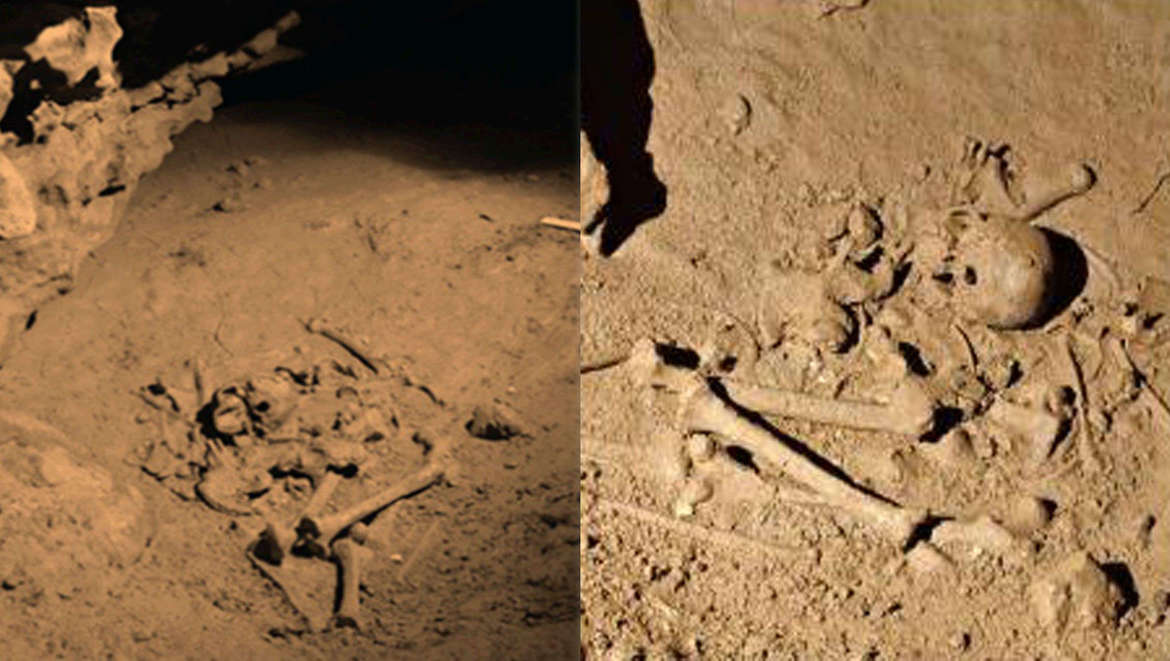Funeral rites emerged at the dawn of humanity. Rituals involved in the passage into the afterlife and proper care of the dead have always been sacred, but the reasons behind many funerary practices remain buried in time.
Source: Syfy Wire
Deep in a French cave lies an unusual Mid-Upper Paleolithic burial site whose passages almost seem to echo with voices from the past. Most of the rites carried out some 25,000-30,000 years ago are still not well understood. Mysterious drawings of horses, oxen, and mammoths gallop across the rocky walls. Skeletal remains rest in graves smudged with red ochre, but why some of the bones are missing is still unexplained, as is the significance of who was buried there. Archaeologist Eline M.J. Schotsmans and her team are trying to demystify these secrets.
Grotte de Cusac, in Dordogne, France, can only be studied by observation, since the French Ministry of Culture has designated the cave a national heritage site with restricted access. Schotsmans recently published a study on her team’s observations in PNAS. There has not yet been an excavation.
Though even gloved hands are barely allowed to touch anything, one aspect of the cave that could handle a more in-depth approach has been the intricate artwork. Figural drawings of animals are superimposed onto other animals, with horses and oxen dominant on the upper halves, while woolly mammoths rule the lower halves. It is known that there was a Paleolithic association of mammoths with women. Men during this era were the ones who would hunt such beasts, while women were relegated to the domestic realm, so the explicitly female representation remains unclear. So does the rest of the mural.

“The meaning of the drawings must be a link with the human remains found in the cave,” Schotsmans tells SYFY WIRE. “Many of the engravings are superimposed and there are additions made to the engravings which indicate that the parietal art was not a final result. It was probably part of a narrative, of an art performance. It was meant to connect people and to exchange.”
But who was the audience? Was it the living commemorating those who had gone before them, or the spirits of the dead?
It is possible there was some sort of mystical connection made with this visual narrative, like other forms of interaction with the dead. It was not uncommon for ancient tombs to be illustrated, but when pyramids rose in the Egyptian desert millennia later, their grand visions of the afterlife would be sealed away after the burial of a pharaoh. This much earlier example suggests that the drawings, for one reason or another, were constantly being added to. Perhaps the superimposed animals were symbolic of lines of ancestors who had already taken the journey to the underworld. These were the bodies that had been buried in and possibly painted with red ochre.
“Ochre is a sign of symbolism. It shows that the deposition is deliberate and not just a dead body abandoned in the cave,” Schotsmans explains. “In general, the use of ochre is a sign of modern human behavior and cognitive development in the middle Stone Age. This is not usually questioned, as many burials from this time period have ochre, but it does say something about symbolism.”
The Red Lady of Paviland is one of the most famous examples of bodies symbolically painted in red ochre. This partial skeleton dates to around the same time period the bodies at Grotte de Cusac were laid to rest, and named for the brilliant red color of the bones, which were later analyzed and found to be male. There is a suggestion of social status by the other artifacts buried with this man, which reveal that he may have been a hunter. He also appeared to have received preferential treatment. Evidence indicates that this was a ceremonial burial, and the Grotte de Cusac burials also appear to have involved ceremony and possibly special treatment of some sort.
“We first have to do an excavation to study the age and sex of these individuals. The upper paleolithic society is considered as relatively egalitarian, so I would not say that their burial indicates social status. It indicates social differentiation, but it is not sure on what this is based,” Schotsmans says. “This is still speculation. It could be related to ancestry. That certain individuals become ancestors. But it is unclear on what this is based.”
Many found some way to keep their ancestors’ presence around. The Chinchorro people of what is now Chile would mummify their dead and bring these mummies into their homes to keep their ancestors alive. Every skeleton at Grotte de Cusac (with the exception of one) is missing a skull — though the teeth were curiously left behind. The skeletons are thought to have been moved to this burial chamber (which was actually a series of abandoned bears’ nests) postmortem, and interacted with regularly. Could it be that the living also took certain bones into their homes so it would be as if the dead had never really left them?

“It could well be that they took the crania with them so that the dead could ‘stay’ in the world of the living,” Schotsmans says. “From ethnological examples, we see that it is not unusual that the dead continue their life with the living until a certain point through the manipulation of certain body parts. This could potentially point to some form of ancestry veneration. Of course, this is an interpretation of the observations and all speculative.”
Until Schotsmans and others can shine more than just a flashlight on these mysteries, they will wait in the shadows.
Source: Syfy Wire

































Leave a Comment
You must be logged in to post a comment.